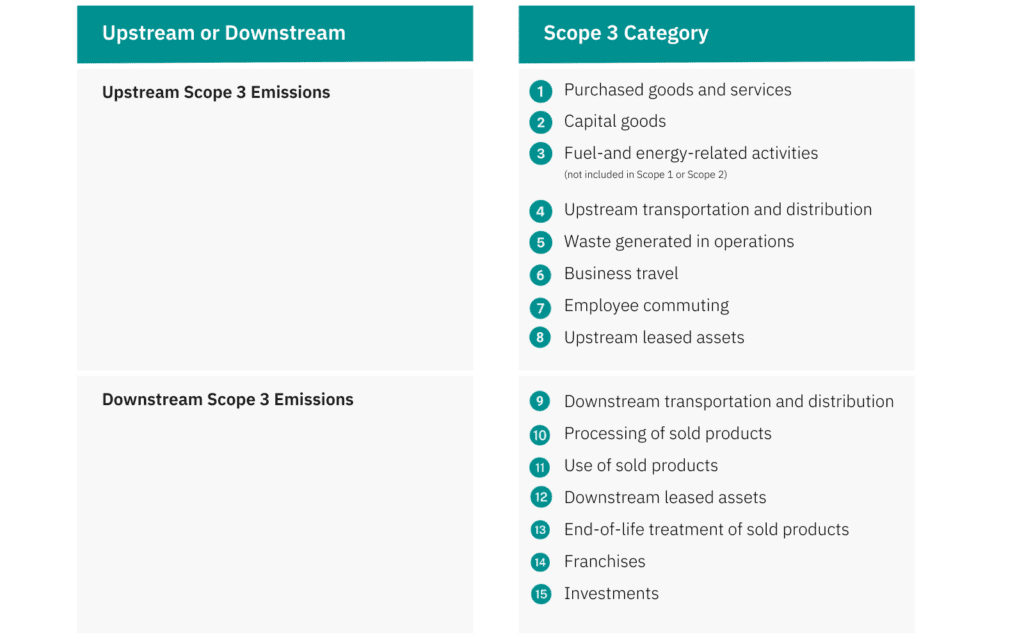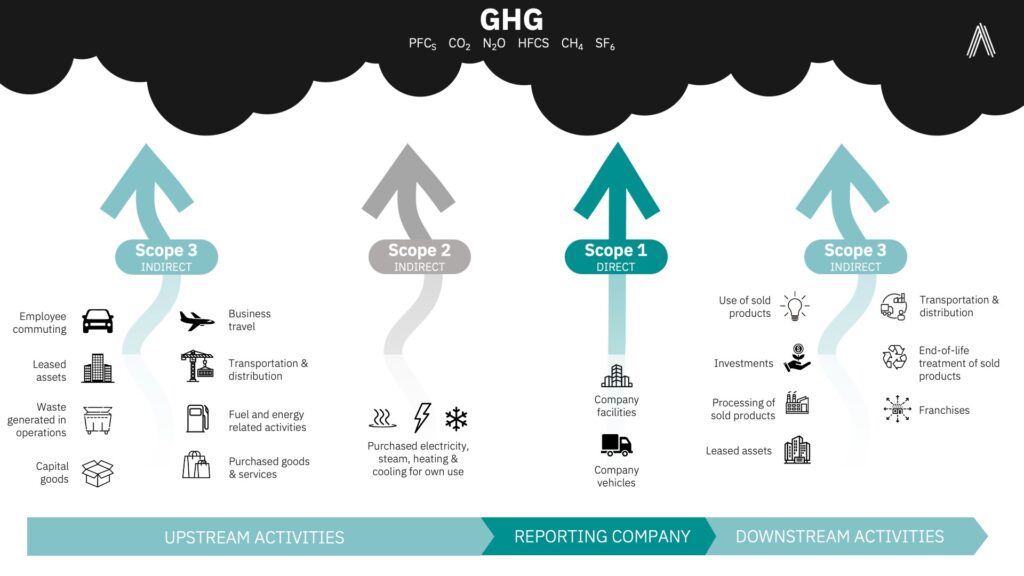Scope 3 emissions reporting gives a more comprehensive picture of an organization’s emissions from upstream sources – such as purchased goods and services, distribution, and employee commutes – and downstream sources – including product or service use, waste disposal, and investments. They make up the majority of organizations’ overall emissions—75% on average. Investors and other stakeholders increasingly demand organizations report Scope 1, 2, and 3 emissions.
Yet, Scope 3 emissions have a reputation for their complexity. This is because the activities that contribute to Scope 3 emissions, such as manufacturing, product use, or leased assets, are not under the direct control of the organization responsible for reporting them. They are therefore classified as “indirect” sources of emissions, similar to Scope 2 emissions. Unlike Scope 2 emissions from purchased energy, which are easy to track with energy bills, there is not always a paper trail for collecting data on the diverse activities covered under Scope 3 emissions.
Understanding these complexities is essential for organizations to overcome the challenge of quantifying their Scope 3 emissions. Technology-assisted reporting significantly helps reduce the learning curve and the time needed to measure and manage Scope 3 emissions. Using the right reporting technology brings actionable, data-driven insights for lowering your environmental impact over time.
Our Atrius carbon reporting platform Atrius Sustainability offers important benefits at each step of the Scope 3 emissions reporting journey.
What are Scope 3 Emissions?
Scope 3 emissions are the sum total of greenhouse gas (GHG) emissions from all upstream and downstream sources linked to an organization’s operations. With 15 total categories defined by the GHG Protocol, the upstream side includes everything from supply-chain emissions to waste emissions generated from manufacturing. Downstream emissions include transportation, product use, and leased assets, among others.
List of Scope 3 Categories:

Similar to life cycle assessment, which looks at the “cradle to grave” environmental impacts of products, Scope 3 emissions calculations factors in the impact organizations have across their entire value chain. These emissions start from the extraction of raw materials and manufacturing stages of production across every step it takes for a product or service to reach the end of its useful life.
The GHG Protocol’s graphic below depicts how operational Scope 1 emissions and purchased Scope 2 emissions relate to Scope 3 value chain emissions in terms of whether the organization directly controls them and the order of activities in the value chain.

For instance, let’s say a coffee roasting company purchases raw coffee beans. The shipment of the coffee beans to the coffee company would generate upstream Scope 3 emissions. The process to roast them may require electricity purchased from utilities, which would comprise Scope 2 emissions. The fuel burned in the roaster’s own delivery trucks to distribute the roasted beans would count as Scope 1 emissions, because the trucks are directly controlled assets. Meanwhile, the emissions associated with brewing the coffee beans would count as downstream Scope 3 emissions, as it comes from the use of the organization’s sold products.
How to Calculate Scope 3 Emissions
Scope 3 emissions data can come from primary or secondary sources. Primary data includes the direct data generated from business activities such as spend data from purchases, fuel-consumption data or data collected directly from suppliers, distributors or employees. Secondary data includes proxies or industry averages collected from governmental research bodies or private research databases.
Organizations should prioritize collecting primary data where possible, and fill in any data gaps with estimates from secondary data sources. For every data point, organizations should then select a relevant carbon emissions factor, a quantity of CO2e associated with different products or business activities across different regions.
Atrius Sustainability is designed to work with both data estimates and data from automated or directly input sources. All of the data, no matter its granularity or source, can be assigned a relevant emissions factor, which converts it into a comparable format. Atrius supports one of the largest collections of carbon emissions factors in any platform; this specificity enables users to analyze and improve the quality of their Scope 3 emissions data over time.
Scope 3 Emissions Challenges
One of the reasons Scope 3 emissions are more complex to manage than the other types of emissions is there are more activities to consider when collecting data. For each of the 15 categories of Scope 3 emissions, there are different strategies for collecting the relevant data.
Beyond the sheer quantity of data collection required, accessing primary data presents another challenge. Time-strapped sustainability managers often reach out to suppliers and other business partners who may have never had requests for emissions data before. Having software that manages these types of processes and workflow is important for ensuring timely, effective communication.
The final challenge is managing data gaps and inconsistencies in the data. Scope 3 emissions data tends to be messy data, supplemented by proxies and estimates. Many organizations simply don’t have the time it takes to pursue high-quality data across all 15 categories of emissions. This is why “perfection is the enemy of the good” in an organization’s process of collecting data and continuous improvement of their management of Scope 3 emissions year over year. Having the right software tool to help organize and improve Scope 3 emissions data analysis is essential for improving emissions reporting

Ways to Simplify Scope 3 Emissions Reporting
Atrius Product Managers worked closely with our internal sustainability managers on our organization’s Scope 3 emissions reporting. Through our learning in the field, Atrius Sustainability was born. Here are some of the lessons we’ve learned.
Prioritize the Scope 3 Emissions Categories
Not all of the Scope 3 emissions categories will be material to every organization. For many organizations, a much smaller handful of categories represents the majority of their Scope 3 emissions. It’s critical to start the reporting process with a Scope 3 emissions materiality assessment to define the critical categories for your organization. This way, prioritizing the collection and reporting of these emissions becomes easier.
Going further, it’s important to start with the categories for which primary data is readily available. For instance, you can use spend-based data for purchased goods and services, while fuel consumption can help organizations estimate business travel and employee commutes. After that, you can determine how to approach data collection for the other categories.
If you don’t have the time or resources to become experts on each of the categories, Atrius aligns with industry best practices for reporting. Atrius is built using the GHG Protocol’s recommended methodologies, so customers can feel confident configuring their data.
Clearly Communicate Data Collection Needs
Reporting Scope 3 emissions isn’t just challenging because of the data. It requires teams and managers to step outside their comfort zone and engage new audiences with a sustainability problem. These are suppliers and product designers who may have never thought about reducing carbon emissions.
Updating your Supplier Code of Conduct and other contractual agreements to reflect your carbon emissions data collection needs is a useful way to formally engage with those outside your organization. This sends a clear message that carbon emissions data matters to your organization.
Within the Atrius platform, emissions data can be input by external associates, too. This means organizations can share the platform with their suppliers or employees who can directly input data into their carbon management system.
Lean into Continuous Improvement
Scope 3 emissions reporting requires an expectation that the data collection processes and analysis will improve over time. In the first year of reporting, it is enough to focus on reporting from primary data within the main categories material to the organization per the Scope 3 emissions inventory. After that, you can implement systems and processes to improve data collection each year. For any year-over-year changes Atrius Sustainability notes the changes, creating an audit trail to easily reference.
Once you start collecting the data, our highly customizable data visualizations help communicate your organization’s Scope 3 impact. With these dynamic dashboards, organizations can tell a compelling sustainability story to engage others. Business relationships across the value chain will start to understand why Scope 3 emissions are important and get involved.
The important thing to remember is to just start. You don’t have to have everything figured out, especially with the support of our knowledgeable team at Atrius. Finding a solution that grows with the business and helps you on the journey is crucial.
